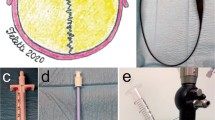Abstract
Background
In intraventricular surgery using a flexible endoscope, the lesion is usually aspirated via the working channel. However, the surgical view during aspiration is extremely poor because the objective lens is located adjacent to the working channel.
Method
To address this issue, we developed a novel surgical procedure using an angiographic catheter. In this procedure, the catheter is inserted into the working channel, and the lesion is aspirated through the catheter. Besides, continuous intraventricular irrigation is performed via the gap between the catheter and the working channel.
Conclusion
This procedure maintains a clear view during surgery and reduces complications.





Similar content being viewed by others
Data availability
Not applicable.
Code availability
Not applicable.
References
Basaldella L, Marton E, Fiorindi A, Scarpa B, Badreddine H, Longatti P (2012) External ventricular drainage alone versus endoscopic surgery for severe intraventricular hemorrhage: a comparative retrospective analysis on outcome and shunt dependency. Neurosurg Focus 32:E4. https://doi.org/10.3171/2012.1.FOCUS11349
Deinsberger W, Boker DK, Samii M (1994) Flexible endoscopes in treatment of colloid cysts of the third ventricle. Minim Invasive Neurosurg 37:12–16. https://doi.org/10.1055/s-2008-1053442
Elshamy W, Burkard J, Gerges M, Erginoglu U, Aycan A, Ozaydin B, Dempsey RJ, Baskaya MK (2021) Surgical approaches for resection of third ventricle colloid cysts: meta-analysis. Neurosurg Rev 44:3029–3038. https://doi.org/10.1007/s10143-021-01486-5
Feletti A, Basaldella L, Fiorindi A (2020) How I do it: flexible endoscopic aspiration of intraventricular hemorrhage. Acta Neurochir (Wien) 162:3141–3146. https://doi.org/10.1007/s00701-020-04499-z
Feletti A, Fiorindi A, Lavecchia V, Boscolo-Berto R, Marton E, Macchi V, De Caro R, Longatti P, Porzionato A, Pavesi G (2020) A light on the dark side: in vivo endoscopic anatomy of the posterior third ventricle and its variations in hydrocephalus. J Neurosurg 135:309–317. https://doi.org/10.3171/2020.4.JNS20493
Feletti A, Stanzani R, Alicandri-Ciufelli M, Giliberto G, Martinoni M, Pavesi G (2019) Neuroendoscopic aspiration of blood clots in the cerebral aqueduct and third ventricle during posterior fossa surgery in the prone position. Oper Neurosurg (Hagerstown) 17:143–148. https://doi.org/10.1093/ons/opy324
Komatsu F, Komatsu M, Wakuta N, Oshiro S, Tsugu H, Iwaasa M, Inoue T (2010) Comparison of clinical outcomes of intraventricular hematoma between neuroendoscopic removal and extraventricular drainage. Neurol Med Chir (Tokyo) 50:972–976. https://doi.org/10.2176/nmc.50.972
Longatti PL, Martinuzzi A, Fiorindi A, Maistrello L, Carteri A (2004) Neuroendoscopic management of intraventricular hemorrhage. Stroke 35:e35-38. https://doi.org/10.1161/01.STR.0000113736.73632.F6
Neki H, Shibata A, Komine H, Kohyama S, Yamane F, Ishihara S, Kikkawa Y (2021) Use of flexible endoscopic aspiration for an intraventricular small floating clot with hemorrhage: a technical note. Neurosurg Rev 44:2363–2367. https://doi.org/10.1007/s10143-020-01392-2
Toyooka T, Kageyama H, Tsuzuki N, Ishihara S, Oka K (2016) Flexible endoscopic aspiration for intraventricular casting hematoma. Acta Neurochir Suppl 123:17–23. https://doi.org/10.1007/978-3-319-29887-0_3
Acknowledgements
We would like to thank Editage (www.editage.com) for English language editing.
Author information
Authors and Affiliations
Contributions
Study conception and design: KY. Data collection: KY. Writing the article: KY. Revising the article: all authors.
Corresponding author
Ethics declarations
Ethical approval
The institutional ethical review board approved the off-label use of angiographic catheters in this report (protocol number 23–05). All procedures employed in the present study were performed in accordance with the ethical standards of Fujita Health University and the 1964 Helsinki Declaration and its later amendments. The patient has consented to the publication of this case report.
Consent to participate
Written informed consent was obtained from the patient for off-label use of the angiographic catheter.
Consent for publication
For Fig. 5, which can be used to identify individuals, consent for publication was obtained from everyone in the photograph.
Conflict of interest
The authors declare no competing interests.
Additional information
Publisher's Note
Springer Nature remains neutral with regard to jurisdictional claims in published maps and institutional affiliations.
Key points summary
1) A flexible endoscope, which is equipped with a 2.0-mm working channel, is required to perform the surgical procedure described in this paper.
2) A Y-shaped connector for endovascular surgery is connected at the outer end of the working channel.
3) An artificial CSF infusion line is connected to one end of the Y-shaped connector, and an angiographic catheter is inserted through the other end. This mechanism allows continuous intraventricular irrigation through the gap between the working channel and the catheter.
4) The catheter should be 4 Fr so that it can be inserted into the working channel without difficulty, and a catheter with a slightly curved tip, such as the Berenstein type, is recommended.
5) A semi-rigid 17.5-Fr peel-away sheath is inserted into the lateral ventricle. The insertion position depends on the location of the intraventricular lesion.
6) A flexible endoscope is inserted into the lateral ventricle to locate lesions and normal structures.
7) After manipulating the catheter together with an endoscope to bring the catheter tip into contact with the lesion, the lesion is aspirated manually. The catheter tip is carefully observed during aspiration to ensure that the normal structures are not aspirated.
8) The direction of the catheter tip can be easily changed by simply rotating the catheter without manipulating the endoscope.
9) To avoid unexpected injury to normal structures, catheter insertion should be performed when the endoscope tip is positioned within the sheath and not when the endoscope tip is near critical structures.
10) The off-label use of angiographic catheters in endoscopic procedures should be approved in advance by the institutional ethical review board. Informed consent should also be obtained after explaining to the patient that this is an off-label use.
Supplementary information
Below is the link to the electronic supplementary material.
Supplementary file1 (MOV 254548 KB)
Rights and permissions
Springer Nature or its licensor (e.g. a society or other partner) holds exclusive rights to this article under a publishing agreement with the author(s) or other rightsholder(s); author self-archiving of the accepted manuscript version of this article is solely governed by the terms of such publishing agreement and applicable law.
About this article
Cite this article
Yamashiro, K., Higashiguchi, S., Hayakawa, M. et al. How I do it: endoscopic evacuation of intraventricular lesions using a flexible endoscope in combination with an angiographic catheter. Acta Neurochir 166, 44 (2024). https://doi.org/10.1007/s00701-024-05948-9
Received:
Accepted:
Published:
DOI: https://doi.org/10.1007/s00701-024-05948-9




